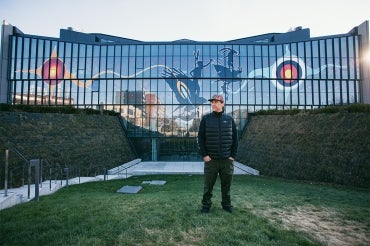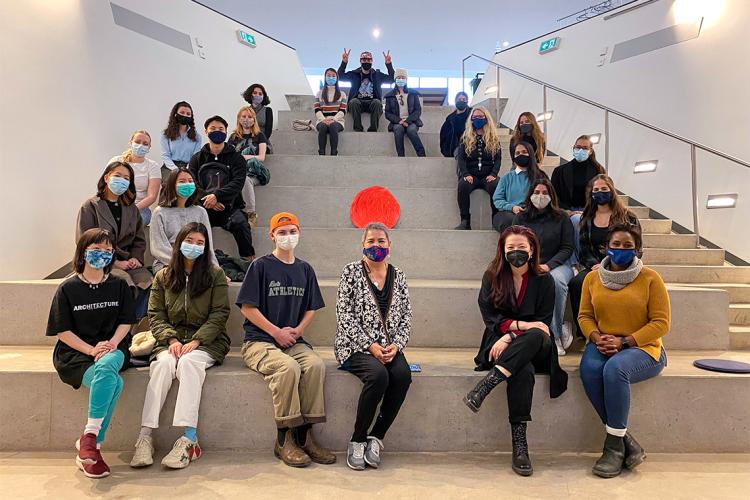'A visual healing experience': Que Rock mural adorns John H. Daniels Faculty of Architecture, Landscape, and Design

Indigenous artist Que Rock stands in front of the mural he created for the north facade of 1 Spadina Crescent (photo by Nadya Kwandibens/Red Works Photography)
Published: January 13, 2022
The north facade of the building housing the University of Toronto’s John H. Daniels Faculty of Architecture, Landscape, and Design is now home to a sprawling work by multidisciplinary artist Que Rock, a member of Nipissing First Nation.
The design – first selected on the National Day for Truth and Reconciliation, also known as Orange Shirt Day – honours the 215 children whose unmarked graves were discovered in May of last year at the site of a former residential school in Kamloops, B.C., as well as the graves that continue to be uncovered across Turtle Island.
The mural itself was completed in late November.
“My goal is to portray the teachings of my ancestors, sacred geometry and the Laws of Nature in all my art forms,” says Toronto-based Que Rock, who is also a musician and dancer. “The goal for the Daniels Mural Project is a visual healing experience.”
Symbolizing the Seven Grandfather Teachings of humility, courage, honesty, wisdom, truth, respect and love, the mural features a sun anchoring the eastern end of the facade extends westward toward the opposite side, where a Grandmother Moon represents the connection to Turtle Island, the water nation and Mother Earth. At the centre of the mural, which is shaded with the colours of traditional medicine wheels, children are carried by eagles to the spirit world. The eagles also carry fish for a healing journey.
The installation was initiated by Elder Whabagoon, the First Peoples Leadership Advisor to the Dean, in partnership with the Daniels Art Directive (DAD), a student-led group that spearheads exhibitions, workshops and community projects. At their behest, the faculty put out an open call for mural proposals from First Nations, Métis and Inuit artists living in the Greater Toronto Area and Hamilton. Submissions were reviewed by an advisory panel comprising members of U of T’s Indigenous communities: James Bird, Melissa Deleary, Jaime Kearns, Robin Rice and Brenda Wastasecoot.
“We wanted to initiate a response to the Truth and Reconciliation Commission’s Report and to U of T’s Answering the Call: Wecheehetowin,” says Michelle Ng, a fourth-year Daniels student and co-founder of DAD.
“This inaugural Indigenous public-art piece brings people together for healing. It is only the beginning.”

Students from the John H. Daniels Faculty of Architecture, Landscape, and Design added 215 red circles to the installation (photo courtesy of Daniels)
Que Rock’s visual art, including large street-art projects and works on canvas, draw from both Anishnaabe culture and daily urban interactions. With each piece, he aims to convey Indigenous knowledge, the meaning of sacred symbolism and the primacy of nature, articulating it all in a style he describes as “making the woodlands dance.”
After applying the main motifs in the Daniels mural, Que Rock invited students from across disciplines in the John H. Daniels Faculty of Architecture, Landscape, and Design to add 215 red circles to the installation and to participate in workshops aimed at augmenting the circles based on Indigenous teachings. The workshops, led by Que Rock, are being be held in January, February and March.
“I applaud those involved in the mural project for utilizing our building as a canvas of Indigenous expression and for collectively advancing the process of Canadian reconciliation,” says Professor Juan Du, dean of the Daniels Faculty.
The project, which also includes an educator’s guide for discussing the mural with high-school students, is part of equity, diversity and inclusion initiatives at Daniels.

